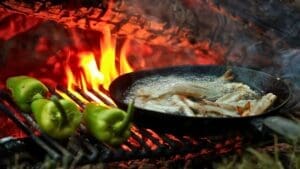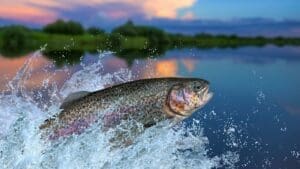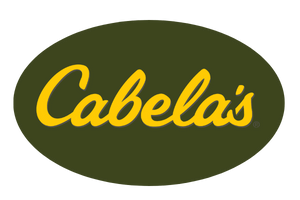How to Read a River: Finding the Best Casting Spots Fast
When you step up to the edge of a river with a rod in hand, you’re not just fishing — you’re interpreting a language. The rocks, currents, eddies, seams, and shadows all tell a story. And the anglers who know how to read that story catch more fish, waste less time, and walk away with a deeper understanding of the river itself.
In this in-depth WildFront guide, we’ll teach you how to read a river like a pro — quickly identifying where fish are likely to hold, feed, or rest, so you can spend more time casting with purpose and less time hoping for luck. Whether you’re chasing trout in alpine streams, grayling in northern rivers, or pike cruising slackwater eddies, these skills apply across species and terrain.
Because great fishing isn’t just about the fly or lure. It’s about knowing where to put it — and why.
- Understanding Fish Behavior
- River Anatomy 101
- Key Holding Zones (and How to Identify Them)
- Reading Surface and Subsurface Clues
- Seasonal River Changes and Fish Movement
- Tools for the Job: Polarized Glasses, Waders, and Patience
- Practical River Reading: Real Examples
- Final Thoughts: Become a River Listener
Understanding Fish Behavior: Why They’re Where They Are
Before you can read a river, you have to understand what fish want. And the truth is — they’re lazy. Efficient, yes. But lazy. Wild fish won’t expend energy fighting fast current unless there’s a payoff: food, oxygen, or safety.
So when you approach any river, ask yourself:
- Where can a fish feed with the least amount of effort?
- Where can it rest and stay protected from predators?
- Where’s the food coming from — and how does the current deliver it?
This is the holy trinity of fish behavior: Food, Shelter, Oxygen. If you can identify where these elements meet, you’ve found a holding zone.
River Anatomy 101: Know the Structure
Every river is different, but they all have certain features that influence fish location. Understanding these basics allows you to decode water anywhere in the world.
1. Riffles
Shallow, fast-moving water over rocks. High in oxygen, good for insect activity. Small fish and trout often feed here, especially near transitions.
2. Runs
Deeper than riffles, with medium speed. These are transition zones — prime for feeding fish that want some depth but easy access to food drifting from upstream.
3. Pools
Deep, slow water where fish rest. Often holds bigger fish. Look for them especially behind large rocks or at the bend in a river.
4. Eddies
Circular currents caused by obstructions like rocks or banks. They trap food and offer rest zones. Fish face upstream in eddies — don’t assume they’re always nose-into-main-current.
5. Seams
Where fast and slow water meet. These invisible lines are highways for fish — offering oxygenated food from the fast side and calm water for easy holding on the slow side.
6. Undercuts and Overhangs
Banks that offer protection from predators, shade, and cooler water. Fish, especially trout, love to tuck under these areas.
Key Holding Zones: Fish Love These Spots
Behind Rocks and Boulders
Large obstructions create current breaks. Behind them, fish rest while watching the current for passing food. These are textbook ambush zones.
Tailouts
The exit point of a pool where current picks up again. These spots often hold feeding fish looking to grab one last snack before heading downstream.
Bends in the River
Inside bends usually have slower water and deeper holes. The outside bend may be shallow but fast — avoid it unless you’re casting into the seam line between the two.
Bubble Lines
Floating bubbles indicate the flow of food-carrying current. Fish often hold just off these lines, watching for surface or drifting insects.
Drop-offs
Where shallow shelves turn deep quickly. Great for larger fish that want to feed near the surface but disappear with one kick of the tail.
Reading Surface and Subsurface Clues
Now that you know where fish tend to be, how do you spot those areas fast?
- Look for Color Changes: Light blue or green often means depth; darker shadows can indicate undercuts or deep pockets.
- Watch the Water Texture: Smooth = slow. Choppy = fast. Boils or swirls often mean submerged structure (and fish).
- Bubble Trains: A moving line of foam or bubbles shows you the seam — cast just alongside it.
- Insect Activity: Hatches or surface dimple rings show feeding behavior. Match your fly or lure accordingly.
Use polarized sunglasses to reduce glare and spot structure below the surface — logs, rocks, shelves. These details tell you everything.
Seasonal River Changes and Fish Movement
Fish don’t behave the same way year-round. Here’s what to expect:
Spring
Melting snow increases flow. Fish may seek out calmer backwaters or shorelines. High water pushes them to the edges. Feed is plentiful, so activity is high.
Summer
Warmer water pushes fish into deeper, cooler pools during the day. Early mornings and evenings are prime feeding times, especially near riffles and seams.
Fall
Fish feed aggressively ahead of winter. You’ll find them in transitional runs and tailouts. Spawn timing also draws fish into new locations.
Winter
Fish slow down. They hold deep, conserve energy, and rarely chase. Focus on pools and slow seams. Use smaller presentations.
Tools for the Job: Gear That Helps You Read Water
- Polarized Glasses: Cut glare and help you see subsurface structure.
- Wading Staff: Helps you feel current changes safely and reach tricky spots.
- Map and Satellite View: Study the area before you go — look for bends, tributaries, and deep runs.
- Notebook or App: Track where you found fish. Look for patterns based on depth, flow, season, or time of day.
Practical River Reading: Real-World Examples
Scenario 1: Small Mountain Stream
You’ve got tight quarters, shallow water, and spooky fish. Focus on:
- Pools beneath waterfalls
- Shade lines from overhanging brush
- Behind and below rocks that create still pockets
Stay low. Use short casts. Dry flies and small nymphs work best.
Scenario 2: Wide River with Mixed Flow
Look for:
- Seam lines between fast and slow water
- Midstream boulders that split current
- Deep pools behind gravel bars or fallen trees
Use a streamer or drift nymph rigs to work the depth layers.
Scenario 3: Post-Storm Conditions
Water is high and muddy. Fish are pushed to the edges. Try:
- Slow, shallow water near the bank
- Slackwater behind large obstacles
- Inlets where cleaner tributaries enter the river
Go with dark lures or flies — silhouette matters more than color in murky water.
Final Thoughts: Become a River Listener
Reading a river is part science, part instinct. The more time you spend on the water, the more the current starts speaking to you. Patterns emerge. You begin to predict where fish will hold before you even make a cast.
It’s not about fishing harder — it’s about fishing smarter. And it all starts with observation.
At WildFront, we believe that every river has its own voice — and it speaks loudest to those who know how to listen. Gear up, get out, and learn to read the water like a local.
Want more backcountry fishing knowledge? Stick with us for upcoming articles on wild watercraft, cooking your catch, and old-school Métis fishing lore that still holds water today.








